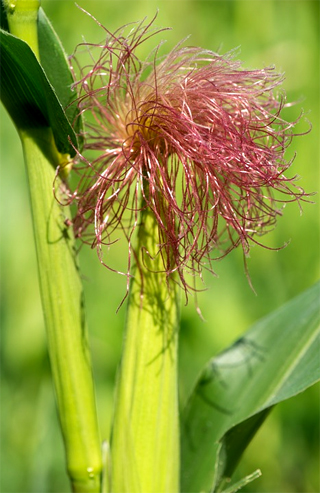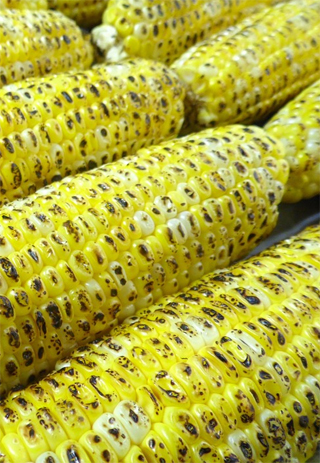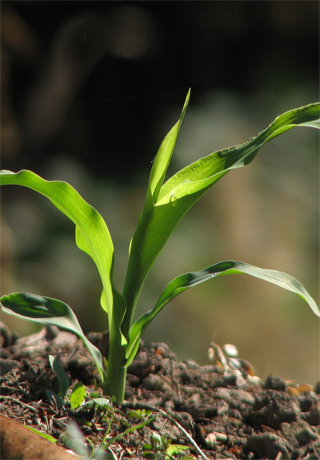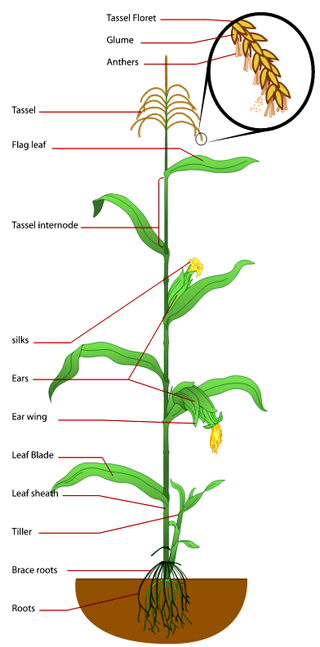
How to Grow the Best Corn in Oregon Washington and B.C.
Corn (Zea mays) is a cereal in the grass family. Although field type corn was domesticated thousands of years ago by natives of Central and South America, sweet corn was first cultivated in the 1800’s.
In addition to old-fashioned open-pollinated types, a huge variety of sweet corn hybrids are now available: yellow, white, bi-color, long-eared and short, with varying sweetness and disease resistance.
Open-pollinated sweet corn offers lower disease resistance and lower yields than hybrids, but produces viable seed.
Other corn types include dent corn, flour corn, popcorn, and broom corn.
Corn requires quite a lot of heat to mature properly, so, instead of listing “Days to Maturity,” catalogs often refer to a corn variety’s HU (heat unit) requirements. Heat units quantify the available daylight hours in a region over 50 degrees (F.) A Pacific Northwest garden may be lucky enough to receive enough heat units to grow an early maturing variety of corn in a summer, while a hotter region may have enough warm days to finish two crops of the same corn. Here in the Pacific Northwest we recommend corn varieties that mature in 80-90 days or less. If you live at a higher elevation or along the coast plant the earliest variety you can find like “Spring Treat” or “Strong Start”.
Corn and Your Health
Sweet corn has a high dietary fiber content, contributing to digestive health. It also provides essential minerals like zinc, magnesium, iron, copper, and manganese. Corn is gluten-free and an excellent source of vitamin A. Like all vegetables, those plants with darker or brighter colors (like yellow or blue corn) have greater nutritional value.
Corn also provides valuable antioxidant phytonutrients – carotenoids in yellow corn and anthocyanin in blue corn.
Seasonal To-do List
Spring:
Prepare bed
Start seed indoors if desired
Direct sow after all danger of frost is past
Harden off transplants in cold frames in late spring
Plant transplants
Summer:
Keep crop weeded
Mulch with compost
Side dress with liquid fertilizer before corn is knee-high
Harvest when silk is dry and brown
After harvest plant a cover crop of clover or fava beans.
Fall:
Clear all old stalks from garden to prevent disease
Location
Although corn is not picky about soil type, you will have larger yields with richer soil. Full sun and good drainage are a must. Corn is wind-pollinated so plant in blocks of at least three rows rather than a single long row. For this reason as well, plant different types at least 40 yards apart to prevent cross-pollination.
Soil Prep
Work in a complete organic fertilizer and finished compost to a depth of 8-10”. Check levels of lime and amend as necessary, as limey soil contributes to high yields. Like other grasses corn needs a lot of nitrogen so a fertilizer like 7-5-5 would be especially valuable. Because nitrogen is not available in cooler soil a shot of fish emulsion when plants are young is also helpful.
Planting
Corn seed will not germinate in soils colder than about 60°F so waiting for a warm period in May is usually best. Dig parallel trenches 6”-8” deep. Put a thin layer of fertilizer in the bottom of the trench, recover with a layer of soil, and plant seeds on top of that layer about every 3”. Cover seeds.
For a continuous supply of corn, plant early and late varieties in your first planting. When the first planting is a few inches tall plant main-season varieties.
To avoid lowering the soil temperature avoid watering until sprouts are growing well if possible.
Thin to 8” apart when 4”-5” tall.
If using transplants, wait until soil is warm and all danger of frost has passed. Harden off in a cold frame. Plant out at final spacing of 8”.
Feed by side dressing or with a liquid foliar spray when about 6”-8” tall. Pull weeds early to keep from disturbing corn roots. If weeds get too big, cut them off rather than pull them up.
Water
Water well and deep: dry corn will make for poor yields. Mulch rows with compost to help retain moisture. Avoid overhead watering when tassles are dropping pollen as this will reduce pollination.
Diseases and Pests
The moth of the corn ear worm lays eggs in the silk, where eggs hatch into worms. The worms feed on the corn silk and then move down into the ear where they destroy the kernels. Treat by spraying with Bt.
Corn borers lay eggs on the axils of leaves and bore into the plant stem. Treat with Pyrethrin.
Japanese beetles must be hand-picked.
The most common disease to afflict corn is bacterial wilt. If wilt is a problem in your area, choose wilt-resistant varieties and rotate crops.
Harvest
Harvest by breaking ears from stalks when kernels are plump and juicy and silk is brown and dry. Keep in husks until cooking time. Store in a cool dry cellar or cold room. 34degrees (F.) is optimum.




